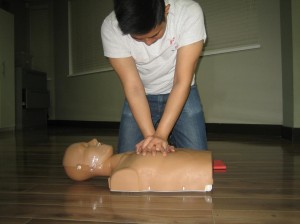A stab wound is a form of penetrating trauma to the skin caused by a knife or similar pointed objects. A stab wound can also be caused by pens, ice picks, broken bottles and even dress hangers. A stab wound requires immediate action to control the bleeding.
https://www.youtube.com/watch?v=Vi861kMrMzk
Treatment
- Call for emergency assistance as soon as possible.
- While waiting for the emergency team to arrive, first lay the affected person on the ground if he/she starts to feel dizzy or becomes unconscious.
If the person has stopped breathing, start cardiopulmonary resuscitation (CPR). - Place a soft padding under the head to make the person comfortable.
- Look and identify all wounds before starting the treatment. If there is a severe wound and there is steady and profuse bleeding, it indicates that an artery is injured which requires immediate medical attention.
- Put on disposable gloves before touching the wound to lessen the risk of infection. If gloves are not available, wash hands or use a hand sanitizer.
- Avoid direct contact with the blood of the affected person to prevent the risk of infection.
- If the person has stopped breathing, start cardiopulmonary resuscitation (CPR).
- Remove the clothing of the person to identify the precise area of the stab wound.
- If the stabbing object is still embedded in the affected area, do not remove it. Pulling out the embedded object increases loss of blood, while pushing it further damages the internal organs.
- Stop the bleeding by applying pressure on the wound using a clean and absorbent material or sterile gauze. If an object is embedded in the affected area, apply firm pressure around it to lessen the flow of blood.
- Reposition the affected person so that the wound is above the level of the heart to minimize blood loss. Let the person sit in an upright position.
- Cover the wound with a dressing and secure using a bandage or tape. Avoid lifting the dressing to prevent disruption in the clot formation and trigger bleeding again. If the dressing becomes soaked with blood, add another towel or cloth over it. If the wound is on the chest, cover it using kitchen foil, a plastic bag or cling-film and cover only the three sides of the wound, leaving one side without a tape or bandage to let air go out from one side of the bandage and prevent entering the pleural cavity in the chest. If there is air in the pleural cavity, the lung will collapse. Continue applying pressure on the stab wound until medical help arrives.
- Shock and loss of blood can cause lowering of the body temperature. Make sure to cover the person with a coat, blanket or other warm materials to keep the body warm.
More Information
The details posted on this page on a stab wound is for learning purposes only. To learn to recognize and manage wounds including a stab wound, enroll in a first aid course with one of our training providers.

